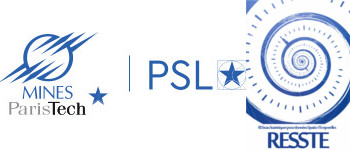Hydrogeochemical data may be seen as a point cloud in a multi-dimensional space. Each dimension of this space represents a hydrogeochemical parameter (i.e. salinity, solute concentration, concentration ratio, isotopic composition...). While the composition of many geological fluids is controlled by mixing between multiple sources, a key question related to hydrogeochemical dataset is the detection of the sources. By looking at the hydrogeochemical data as spatial data, this work presents a new solution to the source detection problem that is based on Gibbs point processes. The proposed model integrates a priori geometrical and geological knowledge regarding the sources. In the same time, it deals with the high dimensionality character of the data. The sources configurations is estimated by the maximum of the probability density describing the model. The maximisation is performed via a simulated annealing procedure based on an adapted simulation dynamics. The simulation dynamics used is an adapted Gibbs sampler. Results are shown on simulated and real data from geothermal fluids.
This work was carried out during the phd thesis of Christophe Reype, under the direction of R. S. Stoica and M. Deaconu. This work has benefited of the close collaboration with A. Richard.

 PDF version
PDF version
